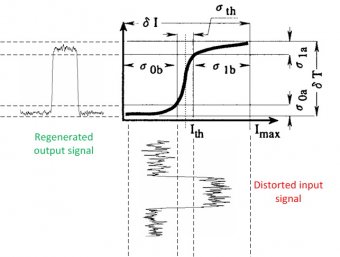3.3 SOA/fiber based optical regeneration
 The optical regeneration was extensively studied during the first decade of our century as an alternative solution to OEO regenerators. Our group had a strong contribution in the field proposing and demonstrating optical regeneration techniques for intensity modulated signals based on the four-wave mixing process (FWM) in optical fibers and semiconductor optical amplifiers. FWM is a nonlinear process generating new frequency products which are intensity and phase copies of the input signals. Under specific operating regimes, the products may have regenerative properties compared to the input signals, mostly referring to the enhancement of the modulation depth of the signals and the suppression of the noise fluctuations at the “1” level. Optical fibers offer the benefit of ultra-fast response and SOAs offer the benefit of the low-cost, small-size devices. The nonlinear properties of the FWM phenomenon in both devices could find application in the emerging field of nonlinear signal processing for telecom and computing.
The optical regeneration was extensively studied during the first decade of our century as an alternative solution to OEO regenerators. Our group had a strong contribution in the field proposing and demonstrating optical regeneration techniques for intensity modulated signals based on the four-wave mixing process (FWM) in optical fibers and semiconductor optical amplifiers. FWM is a nonlinear process generating new frequency products which are intensity and phase copies of the input signals. Under specific operating regimes, the products may have regenerative properties compared to the input signals, mostly referring to the enhancement of the modulation depth of the signals and the suppression of the noise fluctuations at the “1” level. Optical fibers offer the benefit of ultra-fast response and SOAs offer the benefit of the low-cost, small-size devices. The nonlinear properties of the FWM phenomenon in both devices could find application in the emerging field of nonlinear signal processing for telecom and computing.
Related projects:
- PYTHAGORAS I
Significant publications:
- A. Bogris and D. Syvridis, “Regenerative Properties of a Pump-Modulated Four Wave Mixing Scheme in Dispersion Shifted Fibers”, IEEE Journal of Lightwave Technology, vol. 21, pp. 1892-1902, Sep. 2003.
- H. Simos, A. Bogris, and D. Syvridis, “Investigation of a 2R All Optical Regenerator Based on Four-Wave Mixing in a Semiconductor Optical Amplifier”, IEEE Journal of Lightwave Technology, vol. 22, pp. 595-604, Feb. 2004.
- H. Simos, A. Argyris, D. Kanakidis, E. Roditi, A. Ikiades, D. Syvridis, "Regenerative properties of wavelength converters based on FWM in a semiconductor optical amplifier", IEEE Photon. Technol. Lett. 15, 4, pp. 566-568, 2003.
- A. Argyris, H.Simos, A. Ikiades, E. Roditi, D. Syvridis, "Extinction ratio improvement by four-wave mixing in dispersion-shifted fibre", IEEΕ Electron. Lett. 39, 2, pp. 230-232, 2003.
